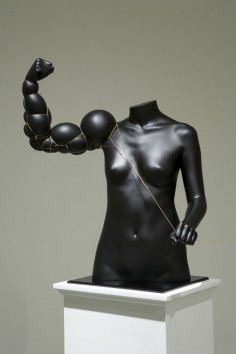LEE BYUNG-HO
BLOW UP

source: wetheurban
Amazing Sculptures by Lee Byung-Ho, implicating muscle growth through a tied string around the sculpture’s arm.
.
.
.
.
.
.
.
source: akiveorg
Byung Ho Lee’s artwork attracted my attention at a group exhibition. Among other installations and sculpture taking a large space in between, snowy-white modest-size pieces of sculpture were placed quietly. His works such as the head statue of a child (Childhood, 2007) and the torso of a man (Torso, 2007) appear to be plaster statues that can be easily found in art institutes or art studios, which makes them intriguing. Why are these pieces here? Are they real plaster statues? I thought while I was passing by his works. At that moment, some fine movement alerted my senses and slowed my footsteps in front of them. The still sculpture was alive – expanding and contracting itself.
His milky and smooth sculptural works inflate and deflate or transform themselves as the air blows in and out under the skin. This transformation triggers interest and attention more than a temporary curiosity. This is probably because the works of art that literally ‘blow up’ or embraces the ‘blow-up’ process blow up the stories the artist intends to unfold while continuously breathing.
Stand in front of his artwork, you will encounter unexpected fun. Your assumptions that the works were made of solid plaster or smooth marble start changing and end up in being shattered when they begin altering. Curiosity kicks in to watch how the once still sculpture undergoes transformation. With his unique ideas and familiar materials like silicone and air, the artist draws attention and laughter from the audience through the repeated process, in which some parts of the works expand and return to their original state.
A skinny man’s chest amplifies larger than that of bodybuilders and a baby boy’s penis moves as if it breathed (SANAI, 2006). A girl’s slim arms develop biceps (Girl’s arm, 2007). A perfect S-shaped well proportioned Venus’ bosom blows up (Volume up Venus, 2008). Who would not be fascinated by these scenes? After witnessing the inflation of the man’s chest and the girl’s arms and Venus’ breasts, people might find their feet glued to the floor because of their expectations that other parts might blow up too. This way his works attract interest and attention, and inflate the expectations of beholders.
Byung Ho Lee draws fun and laughter through the ‘blow-up’ process by using silicone that is soft and malleable and air that is invisible and capable of changing anything. But his works arouses more than amusement in that they are moving or breathing sculpture. In other words, behind this delight are elements for feelings that people can share together. Furthermore, human desire, which is at work by various systems, is hidden beneath. The artist replaces this desire with the air – invisible but powerful enough to change things – and tries to visualize desire, moderation, deterioration and recovery by exposing and restoring the transformation process over time.
In a society where a nice outward appearance is greatly valued, we lament over this social trend. At the same time, however, we demand that women be more ‘volume-up’ than Venus and aspire to become a man with a rock-hard chest and six pack abs or to meet such guys. We smile before his works of art, which is the moment when the consensus is built up on our inflated desire.
In his second exhibition, Byung Ho Lee presents his recent works under the theme of ‘BLOW-UP’. The works made of wood and resin as well as silicone are displayed in the exhibition hall. People swollen to the point of explosion climb and descend, hanging on a rope that stretches from the ceiling to the floor (Rising or Falling, 2007). A ball that is crushed under an extended leg of a tiny bench turned out to be a face of a person with a bleeding nose (Position, 2008). Some people are crushed and stepped on by invisible others and then bloated (Stand-up, 2008). The blow-up process in the works spreads out to the display space, triggering even a sense of nervousness.
Looking at the group of statues placed here and there in the exhibition room, the audience might get amused but feel bitter at the same time. These works cast our images: we work to death under the influence of a distorting force as seen in the head squished by a long leg of the tiny bench, and our inflated body out of incessant desire is crushed by an invisible system and this leads to the blow-up and transformation of other parts of the body. Moreover, this shows the images of the artist himself with a sense of humor to inflate fun and joy and an eye to identify the aspiration and collective mentality of the times. In other words, his artwork reflects his daily life, his joy and burden and the artist himself under the pressure of desire – the invisible power.
The patchwork appearing that someone casts off his skin is placed on the floor at the corner (Sew me, 2008). This work inflates and deflates repeatedly as if it was the other self of the artist who pumps air in and out of his works. As if he was catching his breath for the next BLOW-UP.

